April 2009 archives
you are here [x]: Scarlet Star Studios > the Scarlet Letters > April 2009
<< before
March 2009
after >>
May 2009
April 26, 2009
lsgl: i have a rough draft!
by sven at 3:38 pm
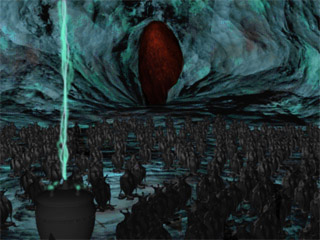
A major milestone: Last night I finished assembling my first rough draft for the film!
Current length: 6 min 38 sec. I expect to hit 7 minutes as things get a bit more fleshed out.
I've watched the whole thing beginning-to-end a few times now, and I can see patches that need minor re-thinking… But the story and the overall structure is now locked in.
Psychologically, having a completed rough draft makes a HUGE difference. Everything from here on out is about improving what I have -- not trying to bridge chasms of the unknown through sheer force of imagination.
…Yay!
This feels like a good moment to re-state and clarify my intentions for this filmmaking journey. Here are my goals, in order of priority:
- work at a livable rate of 25hrs/week
- be done in 2009!
- submit to the H.P.Lovecraft Filmfest by the late deadline of Aug 15
- submit to the Platform International Filmfest (likely deadline Mar 1)
It's more important to me to take care of my health than to finish in 2009… It's more important to finish in 2009 than to make the HPLFF deadline… And if I fail that deadline, I'll still be very excited to submit to Platform. Poetically, HPLFF is about loyalty to the fest that spawned the project -- but Platform is about a future of making films that belong in the company of world-class animators.
It's also worth listing the things that I intend to NOT do:
- push myself to the point where health is endangered
- fail to finish this film
- compromise the quality of my film in order to meet an external deadline
- take this project into 2010 with me uncompleted
I'm on track to meet my 100 hour monthly quota for April. At 25hr/wk, I've got 225 more usable hours before Gretchin & I go on our summer trip to Wisconsin. After that, I've got roughly 100 hours more until the HPLFF deadline. So, 325 hours total.
Can I make the HPLFF deadline? It's so hard to guess. I could divide the number of hours I have by how many incomplete shots I have… Which might mean I've got 8-10 hours available per shot (just guessing)…
But given the massive technical differences between shots, that estimate's not worth much.
Anyway. Did I mention that the rough draft's done? Did I mention "YAY!"…?
posted by sven | permalink | categories: let sleeping gods lie
April 23, 2009
a thousand words is worth a picture
by sven at 2:57 pm
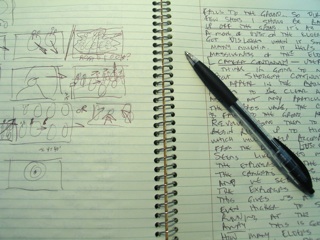
I've written before about the spectrum of pre-viz techniques: thumbnail storyboards, post-it storyboards, polished storyboards on 3"x4" cards, storyreels (slideshows), 2D animatics (limited motion), 3D CG animatics, photo storyboards, photo animatics…
Here's the problem: most of these techniques are really just embellishments upon the thumbnail storyboard… So what do you do when you feel stuck for new thumbnails?
Go back to writing.
When I was re-writing the story for LSGL, it made sense to type -- to brainstorm ideas and options as fast as possible. But for thumbnailing, I gotta recommend pulling out a spiral notebook. The speed of thoughts-to-paper is slower -- but you need to be a little more contemplative, so that's OK. And best of all, as ideas begin to emerge, you can sketch them out on the left-hand pages.
Here's a useful concept I stumbled upon just this morning: camera continuity. When an idea for a shot comes to me, it's usually a composition that looks good as an isolated, static image. But by writing, I've been realizing that the invisible angel who plays cameraman shouldn't just flit about randomly… There ought to be a logic for how the camera is moving between shots.
Example: I've thumbnailed a sequence of 12 shots… It intercuts shots of the Shoggoth with shots of the Elders. Each shot of the Shoggoth progressively zooms in; each shot of the elders progressively zooms out. Also, the shots of the Elders start with them moving screen-right; by the end of the sequence, the camera has revolved around them so that it's in front of the Elders, and they're running straight at the audience. Simultaneously, between shots the camera moves up from a "worm's eye view" on the ground to a "bird's eye view" about 30 feet off the ground.
You could figure this visual logic out all in your head… But I'm a strong believer in "showing your work." As I get my ideas down on paper, it clears room in my head to discover new ones -- work proceeds much faster, even if it seems like a more laborious process.
I've done writing for the sake of generating story before… Doing writing to work out my shot list is new.
I like it. I expect I'll be applying this workflow to future films, too.

posted by sven | permalink | categories: let sleeping gods lie
April 20, 2009
parenting your brainchild
by sven at 11:59 pm
When you produce a piece of art, it could be called your "brainchild." I think it's a really rich metaphor… So here is my exploration of the implications.
conception, pregnancy, birth… and beyond
Lots of struggling artists ask "where do you get your ideas?" It's sort of like they're dating… And they think all the hot muses are already taken. But maybe if you just go to the right bar… What kind of pick-up lines work on ancient Greek chicks?
Where do ideas come from? Well, when an artist and a muse love each other very much… Generally you start with juxtaposition (innuendo intended)… And then things grow from there.
After conception, there's frequently a "gestational" period where you walk around with this thing inside you quietly growing…
Until ultimately you're ready, and go into labor. It can be painful and prolonged -- but seeing a newborn brainchild is a miraculous experience. I made this!
And that's generally where the metaphor ends.
But wait! Don't just leave the newborn in the crib and walk away from it! Its life has only begun!
growing, maturity, finding a career
If you just put your brainchild into a drawer, it dies. A work of art lives and grows by finding an ever-expanding audience.
When a brainchild is born, the first thing to do is call your family… That is, your circle of peers who have a shared love of the art form. Let them know that something new has come into the world, let them come over to your house to meet the thing.
At first, you only introduce your brainchild to the people you trust the most. But still, when company comes over, you put some clothes on your offspring: formatting. If it's a film, burn a DVD. If it's a play or a short story, put the text into a zine-style binding. A stack of papers without a cover, or a video that doesn't have a case… Is naked. It's unseemly.
Showing the brainchild to your peers is its infancy. In its childhood, reach out to a wider audience: email friends who you're less close to, make it available for sale on your website, make it available through local stores. Let the art get to meet people outside of your immediate family.
In the project's adolescence, send it to finishing school: use print-on-demand services to create a book that's perfect-bound or a dvd that's professionally printed and available on amazon.com via createspace or through indieflix.
You've done all that you can to introduce your child to the world and make it socially presentable… Now it's time to send it to college: playwriting contests, film festivals, the like. Places where the work will get tested and graded. Why? Not because the grades mean anything in themselves. It really doesn't matter how you do in school -- what's important is getting recommendation letters.
You can show your brainchild to everyone you know, and then do as much promotion as you know how to do… But ultimately what's going to launch your book or film on a successful career is how it gets reviewed. See, most of us don't just randomly pick up a book or go to a film we've never heard of -- we check things out because someone we trust (who's a fanatic for the art form) thinks they've found a real gem. There's so much crap out there -- it's a valuable service they provide!
And so this is the career of your artwork: to be seen by as many people as possible. It wants to be seen -- your job as a supportive parent is to give it as many opportunities as possible.
Maybe your artwork will even find a high profile employer: a distributor that adds your film to their product line, a theater that produces your play, a publishing house buys the rights for your book. If that happens, then congratulations!
But remember: you don't have to be a doctor or lawyer to have a worthwhile career. Your art may have a very humble career, only reaching a dozen or so people… Do what you can to help it go as far as it can, reach its full potential, even so.
To summarize: A brainchild grows as you put the naked work into increasingly pleasing physical formats. It reaches maturity when it finds its maximal audience. Its career is the length of time that it's alive and active in the world, meeting new people.
the decision to be a parent
Few parents -- I mean artists -- really belabor the decision to have brainchildren. It's just in our nature to create/procreate.
But once the brainchild has left your body… [insert image of Athena bursting from Zeus' forehead] …Then the real challenge begins. It is in our artistic DNA to give birth -- but raising a brainchild takes thought, courage, and perseverance.
Let's take a step backward a moment and consider the subconscious reasons why people want to have brainchildren.
- Money. You like making art -- what concerns you most is how to make a living at it. How are you going to get a job in the field? What kind of art do consumers want to buy right now? How can you get a meeting with the publishing giants who'll give you a contract?
- Fame. Your name is a brand. How do you increase brand recognition? Can the judges see that your art is the best? What's been written about you? Are you known yet?
- Immortality. A variation on fame… Is your work perfect yet? Is it a masterpiece that will be remembered for generations? No? Then maybe you're not ready to share your work with anyone.
- Self-expression. Who cares what anyone else thinks about your work? It is the raw stuff of your heart and soul. If people like it… Then you'll feel understood at last. But if they don't? Ultimately all that really matters is your personal experience, the process of the making. It's about self-love.
I think most artists have some combination of these values in their heads. And I don't mean to say such goals are bad or wrong… Even when taken to extremes. (Personally, I know that my weakness tends to be for the immortality fantasy.)
But here's what I notice about these options… It feels like the brainchild is getting exploited. I want my child to make a million dollars so I'll be rich. I want it to be famous so I'll be famous. I want it to be remembered so I'll be remembered. I'm a bit alienated by the world, and so want the art to stare back at me and say "I understand."
Is that fair to the art?
parent-child boundaries
If we hold on to the metaphor of art piece as child, then these desires all sound like unhealthy relationships. The alternative? Boundaries. To see the art as a separate person. To do what you can to help it grow up strong and true -- but know that ultimately it is its own person.
Translation: Let go of your brainchild and let it leave the nest. It may not be perfect, or an ideal money-maker, or reflect well upon your reputation… But it should have the opportunity to go out into the world and meet people nonetheless.
But why would you let your brainchild leave the house dressed like that? Two reasons: unconditional love, and the fact that we may be poor judges of our own work.
Your art may be lumpy, awkward, misshapen. Even so, don't abuse it (and thus yourself) by calling it names or casting it out. Do everything you can to help it. Take it to the orthodontist and get some braces if you have to. Help it grow by giving it attention and care. And then, when you've done all you can do and have to call it finished… Show it to your peers without apology. Stand behind your work, even if it's an ugly child.
Frankly, it's probably not nearly as ugly as you think, anyway. In general, I think we're fairly poor judges of our own work -- at least in terms of guessing what other people are going to like. The piece you think is awesome doesn't seem to connect with the audience… But the piece you felt ho-hum about turns out to be your smash-hit. It's humbling… So embrace the humbleness.
be fruitful and multiply
One bit of unsolicited advice for potential brainparents: have lots of children. Big families are a good thing.
When you have an only-brainchild -- the masterpiece -- there can be such pressure on it to live up to all your expectations. The brainchild gets lonely… And when you get into fights with it, there's no one else around to help break the tension.
When you birth a couple of children in rapid succession, you learn to mellow out pretty quickly. Whereas you wanted to do everything perfectly with the firstborn, and were a strict parent -- as more come along, you're content just as long as no one breaks a bone. You'll be happier both with yourself and with the kids when you've gotten over that initial "perfect parent" thing.
And, you know what? I suspect that you're more likely to become rich, famous, remembered, and self-loving when you're known for your whole family -- your body of work -- rather than for your one, solitary honor student.
the adoption option
Even if you're able to view your artwork as a separate entity from yourself, there's been an assumption throughout this exploration that what the brainchild is made out of is your own personal Artist DNA. The art is a little piece of your soul that's been pinched off and reshaped into… Adam.
Well, lately I've been exploring what it feels like to instead be a foster parent. That is, rather than looking for the divine spark deep inside of myself, I'm searching the streets looking for orphans who need a good home and some love.
Perhaps the metaphor's become opaque; let me drop pretenses.
What I'm doing lately is using "intuitive collages" as the foundation for image and story generation. I collect huge numbers of images from magazines or online. I select whatever appeals to me in the heat of the moment, without trying to impose meaning. Then I play with juxtapositions until something new starts to appear. When I glimpse some exciting combination, I develop it through writing and then begin work in my final medium (drawing, sculpting, writing fiction, etc.).
The remarkable thing about this process is that even though it doesn't draw directly from my imagination, my imagination is nonetheless engaged and responding. So, while the germinal idea -- the seed for the brainchild -- doesn't come from my own DNA, through the process of developing the material it comes to feel very much my own. Like a child I've adopted.
a finder and a helper
Perhaps artificial insemination is an even better metaphor there? Maybe so.
The thing I like about describing these ideas as fostered or adopted children is that it helps me give up possessive ownership.
I recognize an idea that wants to be born because it has an organic form to it. I love that sense of finding. It's as if the idea has always existed -- it's my job to play midwife for it, then to help it find its way out into the world. But while I may have spotted the idea first, in reality anyone could have discovered it and put their own spin on it. The idea belongs to itself. I'm a finder and a helper.
So, ultimately, this is a way of looking at art that has an altruistic spin to it. No, it's not the audience that you're doing a favor -- it's the idea itself that wants to be born and to have a life. A pleasant anthropomophization.
All those selfish reasons for doing art…? Absolutely, I still get a hit of satisfaction when my work succeeds in those ways. But there's something about this caring detachment that seems to keep me in the right headspace -- dutifully doing the work that needs to get done.
It's joyful.
posted by sven | permalink | categories: writing
April 18, 2009
birthday card: michael granberry
by sven at 7:00 am
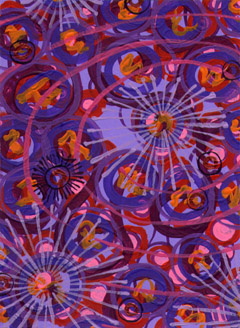
Today is Michael's birthday...
From Sven & Gretchin: happy birthday Michael!
posted by sven | permalink | categories: painting
April 16, 2009
lsgl: how to choreograph a stampede?
by sven at 4:00 pm
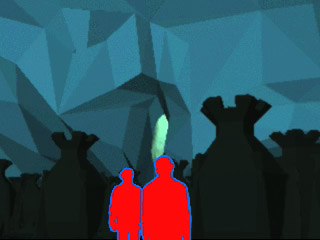
My guiding principle with LSGL right now: work from rough to polished. I'm trying to do a low-res stand-in for every shot, so I can feel the shape of the film, get a sense of it as a whole.
I'm making progress… But boy is this stampede sequence a headache!
I'm discovering that I tend to brainstorm static compositions… Little thumbnail storyboard frames that look pretty on paper. But frame composition really ought to be secondary to telling the story…
So I pull back and start thinking about what forces are at work in this sequence. Really it's about the human explorers being confronted by the Shoggoth. The Elders are a red herring: a lot of noise and chaos that up the jeopardy -- but they aren't the main dramatic interaction. So I try blacking out all the Elder shots, so I can see how the Shoggoth and explorers are getting juxtaposed…
This would be a lot easier if I was working with a fixed set. But no, I started out with the notion that "all that matters is what the camera can see" -- and so there's no master map of where different characters are standing in relation to one another. I'm having to work backwards from the shots I want to keep, trying to infer how big the cave is and how far apart the Shoggoth and explorers are during the course of Act 3.
I can do the math to figure out how long it should take the Elders to get away from the Shoggoth based on their rate of movement… But this is again made more complex by the fact that I can't have everyone waking up all at once. Waking up, standing up, and running, has to be staggered amongst different clusters in the hive. And somehow I have to pick out moments and present them so that they seem true to a natural pace.
I've said it before: I could not have given myself a more difficult animation project had I intentionally set out to do so.
I can see it now… When the credits roll, they should read:
posted by sven | permalink | categories: let sleeping gods lie
April 14, 2009
reading frenzy sells "buried piano"
by sven at 7:00 am

My booklet, "The Buried Piano And Other Plays," is now being sold at Reading Frenzy. It costs $3 and will be available for at least the next 3 months.
Reading Frenzy is located at 921 SW Oak St., Portland OR, 97205. It's open daily from 12-6. The store's mission:
"Reading Frenzy -- An Independent Press Emporium -- is a multifaceted hybrid project: part book, zine and comic shop, part art gallery, part community hub and event space. Founded in 1994, we are devoted to supporting, promoting and disseminating independent and alternative media and culture, with a focus on the arts, politics and current events, d.i.y. culture, comics, girl's stuff, queer notions, and quality smut. We stock thousands of hard to find titles from around the country, host dozens of literary and art events every year, and support local community organizations who share our goals of fostering freedom of speech, information and creative expression."
Last week I offered free copies to our blog readers… That offer still stands -- but you only have until Friday to speak up.

posted by sven | permalink | categories: writing
April 10, 2009
all is well
by gl. at 9:58 pm
comments are better after a little nap. welcome back, comments!
(and thanks, mph!)
posted by gl. | permalink | categories: administrivia
technical difficulties
by gl. at 11:25 am
comments are experiencing seasonal allergies. please stand by.
posted by gl. | permalink | categories: administrivia
birthday card: michael hall
by sven at 7:00 am

Wednesday was mph's birthday...
From Sven & Gretchin: happy birthday Mike!
posted by sven | permalink | categories: painting
April 6, 2009
freebie: the buried piano & other plays
by sven at 7:00 am

Freebie! For a limited time, I'll send anyone reading this blog a copy of my new booklet, The Buried Piano & Other Plays. All you have to do is email your snail-mail address to sven (AT) scarletstarstudios (DOT) com. (Even if I already have your address, please.)
The booklet is 34 pages long, and contains four plays:
- The Buried Piano
Gina's parents are powerful patrons of the arts… But when her "edgy" boyfriend gets kicked out of the party, she realizes she can't tolerate playing the good daughter anymore.
- Re-Imagining The Bomb
General McGraw asks a group of artists to help improve nuclear weapons' public image… And gets more than he bargained for.
- Hell's Merry-Go-Round
A mysterious figure offers to grant 10-year-old Becky a life of adventure… Unfortunately, she gets her wish.
- The Astronaut & The Nude
A man who seeks the giant squid and who rockets into outer space… A woman who dreams she's shrinking to the size of a pea -- and growing larger than the world… How will their marriage survive?

posted by sven | permalink | categories: writing
April 5, 2009
lsgl: illogic is the plan
by sven at 5:25 pm

As of April 1, I'm officially back at work on Let Sleeping Gods Lie. My target is 25hrs/wk for 13 weeks… Then we have a road trip to Wisconsin.
Time spent on the storyboard hasn't been wasted… But I keep finding ways that it just doesn't work on screen. So now I'm trying to push pixels around in a more painterly way, finding my way by doing whatever comes to mind next. So long as I don't spend too much time completing a shot -- only to discover that it doesn't even fit in the story -- I think I'm OK.
The idea is that before logic can be imposed on art, first there must be a pool of illogical material to organize. I've got lots of experience doing intuitive collages… How well can I apply that mindset to film work?
posted by sven | permalink | categories: let sleeping gods lie
April 4, 2009
1440
by sven at 11:20 am
This is an essay about the poetry of numbers. I'm just playing -- don't let the math scare you.
1440
There are certain numbers that all stopmoes should know. 1440 is one of them.
It's a very interesting number. Why? Because it appears in two separate contexts.
1440 is the number of minutes in a day. 60 min/hr x 24 hrs = 1440.
1440 is also the number of frames in a minute of film. 60 sec x 24 fps = 1440.
So think about this: If it took you one minute to shoot one frame of film, then for every 24 hours of work, you'd produce one minute of animation.
That's one day of your life in the real world exchanged for one minute in the dream world of stop-motion fantasy.
When I was growing up, one of my very favorite books was White Monkey King by Sally Hovey Wriggins -- a retelling of the Chinese monkey king myth. In it, when you spend a day visiting the gods in heaven, something like a hundred years passes on earth. Stop-motion's like that. For every minute you spend in Art Heaven, a day passes on Earth.
5 minutes
Of course, you could shoot at 12fps, in which case you'd be getting 2 minutes of film for every day of your life…
But frankly, estimating that it only takes 1 minute to shoot 1 frame of film is probably off base.
At Aardman, the studio expects animators to shoot no less than 4 seconds of film per day.
Why 4 seconds? I got to thinking about it… The producers need some sort of benchmark for what to expect from animators. If you assume that the animators work an 8-hour day and shoot at 24fps, then 4 seconds of film is the result of spending 5 minutes on each frame. 5 min/frame is 12 frames/hr… Times 8 hrs/day… Equals 4 seconds.
Ah! There's nothing magical about 4 seconds of film per day -- it's just a benchmark based on a generous estimate for how long an animator has to create a puppet pose.
So, at Aardman then… Animators regularly trade 24 hours of their actual lives for 12 seconds in the filmic fantasy world.
The currency exchange rate is worse for professionals than for amateurs.
1:1
It frightens me to think about the rate at which my real life is escaping me as I breath life into puppets…
But here's something that's unusual about time in the Puppet Universe: it repeats. When I make a one-minute long film, I can play that film as many times as I like. A one-minute film that's played ten times takes up ten minutes of real world time.
So I start to wonder… How many times do I need my film to be seen to offset the amount of time I've invested in it?
Let's say that there's a 1:1 ratio when you're having a conversation with a friend. That is, for every minute that I'm talking, my pal spends one minute listening to me. And let's say that the effort of paying attention is of perfectly equal value to the effort of communicating…
Well then, if it takes me 1440 minutes to make a 1-minute film, then I would want my friend to watch this bit of communication 1440 times. Or, more realistically, I'd want an audience of 1440 people to watch it once.
I think it's kind of interesting -- just being playful -- to think that you could calculate what size of audience is required for you to break even for the time you invest in a film… Not in terms of money, but in terms of attention paid.
Time-wise, stopmo is certainly one of the most expensive art forms around… If all you spent was 1 minute per frame, then for a 10-minute film you'd need 14,400 people watching before you made back your investment.
Contrast this with writing. When I'm writing non-fiction at a good clip, I know that I can put out 2.5 pages per hour -- that's 20 pages in an 8-hour work day. I also know that when I'm reading non-fiction by other authors, I can only get through about 20 pages per hour. Assuming other people read as fast as I do, then we've got a 1:8 ratio. That is, it only takes an audience of 8 persons to "break even" for the attention I invested in writing.
Well, of course when I do a moderate editing job, I can only put out about 10 pages per day -- so I'd need 16 readers. And when I do a really meticulous editing job, I only put out 5 pages per day -- so I'd need 32 readers…
But even so! A ratio of 1:32 is not even close to 1:1440… Which, I should point out doesn't even begin to take account of the time spent on scriptwriting, fabrication, lipsync analysis, and post-production for your animation.
Consider for a moment people who do live improv. If you can just walk onto stage and start performing, without any time spent on rehearsals…? Then you've got a winning proposition! If you have 100 persons in the audience watching you, then for every minute of time you invest, you get 100 minutes of their attention in return!
It's rather sobering… Maybe this 100:1 ratio suggests that people who perform for live audiences have a responsibility to invest rehearsal time proportionate to the time that people will spend watching. Thus, if I'm going to be acting in a one-hour-long play for 100 people, then it behooves me to invest 100 hours in preparation.
Interesting.
$12.50
Gretchin teaches a class called "Creative Business Basics." One of the most important parts of the class deals with how to price things that you're selling. The basic idea: fair price = (hours it takes to make a thing x a living wage of $12.50/hr) + (cost of materials) + (50% of all that, for profit - so your business can grow).
[Quick example: If I'm selling a painting where materials cost $7.50 and I spent 1 hour working at $12.50 per hour (sub-total $20), then I would need to add $10 for profit… Winding up with a fair price of $30 for the painting.]
One of the crucial numbers in Gretchin's equation is $12.50/hr, which is what's considered a livable wage.
I started wondering… Where did that number of $12.50 come from? Well, if you work 40-hour weeks during a 4-week month, then $12.50 works out to be $2000 per month (before taxes). Ah! …And it also works out to be $100 for an 8-hour work day. I begin to see why $12.50 is such a lovely, useful, round number to keep in mind!
So, going back to my original premise about the magic number of 1440… If it takes 24 human hours to produce 1 puppet minute, then the labor for that minute should be valued at $300.
Or, given our estimate that pro animators spend 5 minutes per frame of film, 1 minute of professional-quality puppet animation would cost $1500.
I'm curious to apply this logic to other aspects of stopmo production… It can take me up to 50 hours to machine a ball&socket armature from scratch. That would be $625 labor, maybe $20 worth of materials… So with a conservative mark-up (50%) to ensure studio growth, I ought to sell the armature for $967.50.
[Actually, pro armature makers are more likely to be paid $15/hr… In which case the armature would be sold for $1155.]
I recall that my Percy 5 puppet took almost exactly 24 hours to fabricate. So, considering only the time spent on him, my simple wire and Sculpey puppet represents an investment of $300.
Now, just because your time is (hypothetically) worth $12.50/hr doesn't mean that you shouldn't work unless you can get your money back! To the contrary, there are plenty of experiences that I would happily pay my own money for… Taking classes for example.
Would I spend $300 to take a class on making Percy 5? Or a $1000 class on making armatures? Or a $1500 class on how to make a one-minute film? Hell yeah! Particularly if the teacher I was paying happened to be myself.
happiness
Happiness? Sorry, can't help you.
Sure, it ought to be part of these wacky equations… But how to quantify it? I have no idea.
Being pleasurably absorbed while working with your hands… The tangible connection forged between your dreams and reality when puppets come to life… The pride in having finished a 100-mile marathon… The magic of having created a dream that other dreamers can step into…
You're on your own.
posted by sven | permalink | categories: stopmo
April 3, 2009
the myth of storyboards
by sven at 7:00 am
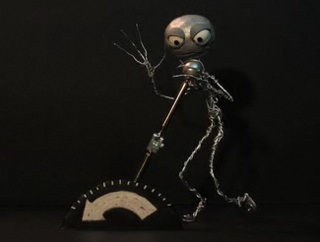
Speaking for myself: making animated films has been agony.
I love the end product. I love the little hit of "progress!" every time I snap another frame. And I love working with my hands to create little worlds.
But when I discover my sequence of shots doesn't work, it's misery. When I realize that good storytelling demands I excise a shot, I feel a day ripped from my life for nothing. And then of course, there's when a film turns into Viet Nam: the quagmire you're too committed to to bail out of, even though there's no end in sight.
I don't think I'm alone. I expect my filmmaker friends (stopmo and otherwise) know exactly what I'm talking about.
There's a problem here that I'm still learning how to solve… But I think I've found the principle that will ultimately save me: WORK FROM ROUGH TO POLISHED.
STOPMOES' GREAT TEMPTATION
Based on my own experience and what I've seen at SMA, I believe that almost all stopmoes are cursed with the temptation to dive into fabrication.
We are utterly smitten with the physicality of puppet worlds. We're almost powerless against that lust. What is it that we do? We create actual tangible bodies and then breath our own life into them -- trading the time of our life for time spent in theirs at a frightening exchange rate. We create miniature worlds that we then get to exist in vicariously -- though for us it's far more than six days before we can rest! We can feel as if these people and places are already real -- they're just begging to be born, tugging at our minds…
But I urge myself (and my stopmo brethren) to resist this temptation to start building. We must be storytellers first… Not gods of tiny worlds.
DON'T SKIP STORYBOARDING…
I've found stopmoes surprisingly resistant to the idea of storyboarding. I think it goes back to our great temptation… We want to get straight to fabricating. But also: Storyboarding seems like additional work… And it requires drawing skills… And if you can already see the film perfectly in your head, why bother?
Well, just trust me on this: the pain of storyboarding is far less than that of throwing out shots or getting stuck in a years-long quagmire. (No film is ever as as short as you think!)
I think people tend to imagine that storyboards have to be like the ones we see in "making of" featurettes: beautifully rendered, like storybook pages spread out across a wall. No! Stick figures will do… And there's a whole range of storyboard-like development tools to work with:
- thumbnail storyboards
- 3x5 card/post-it note storyboards
- polished storyboards paired with shot descriptions
- slideshow-style storyreels
- 2D animatics (some moving elements)
- 3D CG animatics
- photo storyboards
- photo-based storyreels
- pop-throughs
- live-action video reference
Always start with the fastest, roughest methods… Refine your vision through progressive iterations. Catching a problem now will save you immeasurable grief later on!
…EVEN THOUGH THE STORYBOARD IS WRONG!
So, stopmoes who go through the trouble of storyboarding their film get to feel virtuous. They fought temptation, did the right thing, and now can get on with fabricating puppets and sets. …Right?
Wrong!
The great myth of storyboards is that they're the master blueprint for your film… All you have to do is shoot the shots you've drawn, and your project will rise like architecture.
But the reality is that despite all this planning, films are created in the editing room. A film is like an iceberg of deleted scenes… What you see on screen is just the tip of what got shot -- 80% of the project never gets seen.
Here are ways the storyboard is going to be just dead wrong…
(A) You fail to get shots that you need. A reaction shot. A close-up. An establishing shot. The shot sequence looked good on paper, but when it plays on screen, it becomes obvious that something is missing.
(B) You shoot unnecessary shots. You realize that pacing works better if you excise the reaction shot. Or if you cut a line of dialogue. Or if you delete the scene altogether and move on to more important stuff… Ouch.
(C) The shot flow doesn't work. Often this has to do with camera angles… The jump from a far shot to a close-up is jarring. The exciting angle from above or below doesn't mesh with the rest of the scene. Characters move in one direction in shot A, and then there needs to be a shot B that somehow continues the motion… Etc.
The more complicated the visuals you're working with, the more likely it is that a storyboard is going to be wrong. If you have any of the following situations, storyboarding alone probably won't be good enough:
- there's a voice track whose timing you need to obey
- multiple characters are moving around in a scene
- you make use of deep space, rather than having things just move in a shallow picture plane
- quick-paced action sequences
- the camera's position shifts significantly between shots in a scene
- any scenes where the camera moves during a shot
Now, in the world of stopmo, a lot of animators avoid lipsync… The acting space in our sets tends to be pretty shallow… The size of the camera relative to the set often prohibits extreme camera angles and camera movements… Even so -- beware! The storyboard helps preview your film, but still has big limitations.
3D STICKFIGURES SHOT AT 4FPS
My advice: When you get an idea for a film, DON'T start with fabricating puppets and sets! And even if you do have your puppets already made, DON'T start filming shots at 24fps! Both approaches are likely to waste days if not years of your life on dead-ends.
Here is the holy grail I'm seeking: a way to preview a 10 minute film -- in motion and start-to-finish -- that can be created in 48 hours.
Part of the solution is pop-throughs. Block your characters. Select your puppets' gestures -- their animation "extremes." Then work pose-to-pose… But don't shoot more than 4fps. You might not even need that, if a character holds poses for a while. Do brainstorming for the pop-through using a hand-held digital still camera, going back and filling in the inbetweens once you've got the keys figured out.
Another part of the solution is to do rough-hewn sets stage-style: either having characters going through their motions in a black-box set, or with cardboard "flats" indicating where 3D set elements and props will go later.
The final part of the solution is to use 3D stick figures.
For a while now, I've been working on the idea of creating a Generic Puppet Actor Ensemble… Six to ten puppets of various sexes, ages, and body-builds -- wearing black rather than special costumes -- which I can draw upon whenever I want to test a scene.
Recently, however, I discovered an even quicker and dirtier approach. Occasionally master animator Anthony Scott updates the splash page of stopmotionanimation.com. This week I noticed that the new intro uses a puppet that's nothing more than a wire armature with a spherical head. Wow! It's the 3D equivalent of a stick figure!
I'm still digesting this revelation… The fabricator in me still wants my rough-hewn yet visually appealing Ensemble… Yet logically, I know the stick-figures are much, much more economical time-wise.
LOW-BUDGET VS. HIGH-BUDGET FILMMAKING
We've all seen enough Hollywood films to know that hiring the prettiest /handsomest / most expensive actor can't save a crap script.
I'm desperately trying to take that lesson to heart… Just because I can make a beautiful puppet, or a phenomenal miniature set, that doesn't mean I've got a story that's going to work.
Doesn't it make sense to figure out whether or not your story / editing choices work before you put years of your life into the project? Why wait until the very end to find out if the film is going to gel?
Granted, for some the vision in mind is too powerful to deny. It must be exorcised one way or the other. But for most of us -- I'm certain that we are filled with dozens of potential stories. We needn't worry that we've only got one story to tell!
In the world of stagecraft, before a script ever goes into production, it's going to get "workshopped." You have volunteer actors read your script aloud -- with only the smallest amount of blocking -- not wearing costumes or trying to deliver a performance. One or two rehearsals at most… And then an audience (often not paying admission) gives the author feedback.
Then, when a script has been polished and is truly ready for production, paid actors are going to give it a read-through… Then later a walk-through with basic blocking… Then the acting is developed and refined through rehearsals… It's quite likely that the actors only get to work with costumes and sets in dress rehearsals during the last few nights before the show goes live.
I believe this is how stopmoes should be thinking, too. Don't create expensive costumes and sets before you've at least done a walk-through for the story…! Don't expect your puppet actor to show up on opening night without ever having had the chance to rehearse their lines and blocking…!
It could be argued that stagecraft is the wrong metaphor for stopmo -- that we should be looking to live action films for inspiration… Well, have you watched the special features on any effects films lately? Whereas only CG sequences used to be given the animatic treatment (e.g. X-Men), now it's becoming common practice to do the entire film as a CG animatic (e.g. Hancock, Jumper) -- even before the actors get hired. Previewing is economical.
Mega-budget films might still be the wrong example… Think then about low-budget filmmaking. There are examples of directors who've made a low-budget student film, and then gone back and done a big-budget remake (e.g. Sam Raimi's Evil Dead was remade as Evil Dead II)…
Even if you're making a live action film, I'd recommend getting your friends together for a 48-hour guerilla filmmaking adventure, shooting hand-held video, everything on one take. It's fast, it's cheap, it's easy -- and you get to discover what's horribly wrong with your storyboard before big money and months of work are on the line.
I'm urging my stopmo friends to try this… But more than anyone else, I'm trying to hammer it into my own head…
Make the stick-figure storyboard. Shoot it with 3D stick-figures. And only THEN think about fabricating beautiful puppets and sets.
Storyboards help -- but they're liars. Don't trust them with the next few months or years of your life.
posted by sven | permalink | categories: stopmo
April 2, 2009
the appeal of comedy and horror
by sven at 7:00 am
[An essay written to some email friends on 3/27.]
I think there's a strong relationship between horror and comedy.
Both are intentionally visceral experiences. At a horror film, you're supposed to feel anxious, revulsion, and startled in your body. When you go to see a stand-up comic, your body is supposed to convulse in laughter.
Physical experiences while you're sitting in safety? Neat trick! And since it's perfectly safe, it almost doesn't matter what kind of physical experience you're getting… They're all interesting at some level.
Comedy and horror also both deal with taboos. And for that reason, both have a sort of fascination because it feels like they reveal Truths that are denied to us in everyday life. We're not supposed to talk about mortality, or that each of us is a fragile being walking around filled with intestines, blood, and gore. ["Not supposed to" because it's upsetting, and being upset interferes with the necessary agendas of daily living.]
Comedy often talks about sex, race, religion… Things that we have a hard time talking about as a society because there are real political tensions there. But the Shakespearian fool and the Native American clown and the social outcasts brought into the center of town for Carnival are allowed to say outrageous things -- under the guise of entertainment -- but also with this understanding that the role allows taboo observations to get heard. I hear comediennes like Sarah Silverman and Margaret Cho being praised for doing comedy in this tradition.
So: horror and comedy -- visceral and truthy.
But also traumatic and addictive.
There's a story I heard once about the Cambodian killing fields; how someone witnessed a group of teenaged boy-soldiers performing executions by bringing baseball bats down on captives' heads. They were laughing as they did it. From how I understood the story, though, this wasn't pleasurable laughter; it was more like the nervous laughter of trauma.
There's a school of psychology -- Re-Evaluation Counseling -- which has not been rigorously tested, incidentally -- that says laughter is psychological distress leaving the body. I think sometimes this is true, but not always. If you look at chimpanzees, they laugh when they're being tickled; but there is also a laughing, toothy smile that is a sign of fear and aggression -- beware! It seems to me that sometimes laughter trickles out as a coping mechanism when a person is absorbing a painful experience, and there's just no other way to deal.
"Sex and violence" are often called "puerile" interests. People often don't realize that the word "puerile" stems from the Latin, "puer," meaning "boy" -- it's a synonym for "childish." I think sex and violence ARE childish interests… In the sense that children have every reason to be interested in procreation, physical pleasure, the level of violence that human beings are capable of doing, and what sort of personal armor you have to wear in order to be ready to face it.
This is very existential stuff, all about what it means to be alive in the world. You're not born knowing it; you have to learn it. And anyone who stands in the way of your getting this information, prevents you from accessing the most vital information for living your life. …Is there a Santa Claus? Think about it -- the answer to that question is going to have a phenomenal bearing on your sense of reality. …Are there psycho-killers afoot? Same thing.
Violence is a sort of truth. Yes, there are murderers, rapists, child abusers, and war in this world. Truth doesn't always "set you free" -- sometimes it weighs you down. But it's necessary. And so, when people condemn how violence desensitizes you, I think they're only seeing half the picture. It's unfortunate to lose one's emotional sensitivity through seeing violence. That's a part of what trauma does: it deadens your vulnerability. But if in fact you are living in a community where you are not physically safe, then wearing some emotional armor is actually a vital thing. Carefree children who pick flowers for the Easter Bunny cannot exist in a neighborhood torn by gang violence.
A long way of saying: there's value in understanding violence, including through portrayal in fiction -- but the cost is emotional sensitivity. Poetically, it's sort of like how a guitarist builds up calluses. If you want to play in the world, being soft isn't always functional.
Horror and comedy are visceral experiences… Adrenalin, endorphins, and the like are internally produced drugs. I can understand the appeal of bungee jumping and other "extreme" sports. Once, I took the opportunity to go sky diving along with a large group of friends. At the end of the day, my nerves were singing. Marathon runners, similarly, often talk about the ecstasy of endorphins when they break past the hard part and get into their "zone."
Well, similar positive reinforcement also happens at a less extreme level. Slot machines in Las Vegas are a good example. There's a heightened sense of expectation when you pull the lever; and when you receive a pay-out, that's a positive reward. I'll never forget, as a child, seeing slot-jockies whose fingers had turned silver from handling so many nickels.
So, that's Behaviorism for you: click a button, get a reward, repeat. Horror shocks, laughter, orgasms, slot machine pay-outs, video game kills, and web surfing can all establish patterns that are difficult to moderate through will power alone. It doesn't matter than you really want to get down to work for the day; if you click the mouse again, you'll get the pleasure of seeing another blog. It doesn't matter that the comedy show you're watching is vulgar; if you stick around, the shock value alone can prompt the visceral "reward" of laughter.
I'd like to also point out that Behaviorism effects art producers as well as consumers. If you watch some comedians, such as Jerry Lewis and Jim Carrey, it won't be long until you spot a certain desperation in their eyes. They come out on stage and there's a powerful visceral thrill of stepping into the spotlight… But then they're looking for the laugh. It's their hit of heroin. Certain individuals don't perform purely out of altruism or capitalism -- when the audience laughs, that positive attention feeds them in a way that they can't live without.
Stopmoes… Well, one of the reasons I like stop-motion better than CG is because every five minutes, when I snap the camera shutter, I get a little hit of "Ah! Progress!" Snapping frames for an animated film supposedly takes "patience" -- but in another way, we get our pay-offs much more rapidly than the slot jockey.
So… Horror and comedy: visceral and truthy -- also traumatic and addictive.
The last thing I'd like to comment on is cultural drift.
Over the years, it seems like horror films get more gruesome (compare "Saw" to "Psycho") and comedy gets more vulgar/edgy (compare "Something About Mary" to "The Wacky Professor"). I don't think this should be surprising. Who goes through the trouble of creating horror and comedy? Enthusiasts. People who've seen it all before. Of course there's going to be an urge to go just a little bit farther, to try to do something that hasn't been seen under the sun yet.
Does new comedy/horror lack the subtlety or "restraint" of previous works? Maybe. But perhaps that's unavoidable. Jaded critics of film, stage, literature, art, philosophy -- whatever -- will tell you that there's nothing new under the sun. Maybe it is possible to exhaust the possibilities of creativity. What then? Stop making art? No, you keep trying to do something new and different -- as difficult/impossible as that may be.
As time goes by, there's likely to be specialization, homogenization, and confusion. There used to just be CG animators… Now, to be a professional, you have to specialize in modeling, texturing, character animation, match-moving, and the like. What was once being invented in the garages of eccentrics generalists has now become an institution that insists on specialization…
With institution comes pedagogy. I look at books about how to write movie scripts, and I realize that these authors are all reading the same books. Everyone is responding to the same "big ideas" of the past 10-15 years. It seems that if I want to find new and original concepts, I actually have to go backwards in time… Because some of the geniuses who invented literary theory, cinematography, animation principles etc. -- have been more or less forgotten. Often I find more truth in the flawed writings of people who invented an art form than in the books of contemporaries operating in an echo-chamber.
So, even though at the beginning of the 20th century, we may have the benefit of 100 years of predecessors (in the art forms revolving around cinema), the intent with which people set out to make art often seems quite confused. It's harder to take in "the big picture"… As an artist, I discover something that I like -- and now more than ever it's possible to get stuck in a ghetto with people who like the same things I do… Referencing nothing but what's already been done in this tiny-yet-densely-packed area.
It's the blessing and curse of the Internet Age: maybe there's nothing left but niches.
posted by sven | permalink | categories: writing
April 1, 2009
micro-collages
by sven at 7:00 am
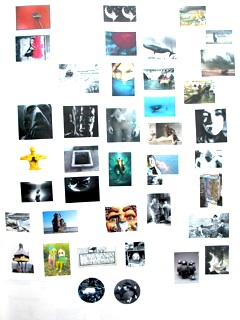
I've developed a new collage form: micro-collages.
Here's how it works: Go online and use Google Images searches, Flickr, National Geographic's website, etc.… Collect lots and lots of images. Collect ones that appeal to you for whatever reason, based on gut instinct -- try to avoid searching for images based on preconception (e.g. "I need a picture of a tree here"). If you have a Mac, you can use "Preview" to print out 16 images per page, each the size of a postage stamp.
Most collage methods have you overlapping images… You could do that here, but because the pictures are so small, I found I wanted space between them so they remained legible. Even so, the juxtapositions created by putting images next to one another are plain.
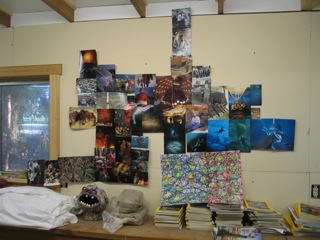
Why this method?
a) to conserve space
When I took Sara Swink's Two Day Creative Process Workshop back in January, I decided to push my own limits and try making a "mega-collage." Rather than fill up the rectangle of a blank page, I just started in the middle and worked my way outward. The 6'x4' monstrosity that resulted is far richer with imagery than most collages I've done -- but there's no good way to store it. By using 1"x1" images to start with, I can put the same amount of visual information into a normal sketchbook spread.
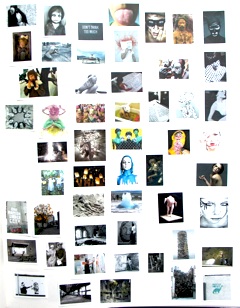
b) to use the internet as an image resource
People who do collaging regularly tend to have stacks and stacks of magazines… But the good stuff starts getting thinned out over time. I figured there must be a way to make use of the internet to find new material. It's a little tricky to get truly random images via Google. I tried using random word generators to help with this; also just doing searches based on words that popped to mind. Flicker, I found, has better randomizing applications -- it's easy to surf from collection to collection.
A side benefit of doing image collection digitally: you get to keep your original image files and use them again in future collages if you find something you really like.
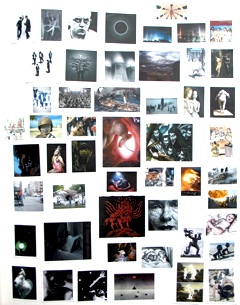
c) juxtapositions are the spark of creativity
It's hard to think of an original idea off the top of your head. Visual prompts really help get the juices flowing. What's more, when you you have a large selection of random materials to work with, you just can't help but make highly personal discoveries. It's like tarot cards: you start reading your own psyche into the unexpected juxtapositions.
Personally, I've found that this method is fantastic for helping me generate story ideas for playwriting and fiction. I wrote the play "The Astronaut & The Nude" based on micro-collage #1. Proof of concept. I'm eager to do more writing based on the other two pieces.
posted by sven | permalink | categories: other art, sketchbook